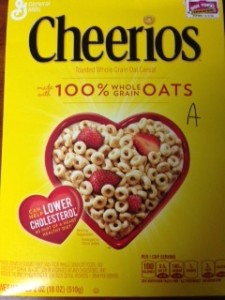
It happens all the time: you’re at the grocery store and you pick up a food product to glance at the nutrition label and ingredient statement. The label is simple, and lists everything a consumer needs to make an informed decision about which products they will and will not buy. Nutrition labels give us the freedom to choose the best product to meet our own personal needs. Avoiding a certain ingredient? Check the ingredients list. Want to eat fewer calories? Check the nutrient label.
Luckily, most companies create several versions of one product so that many different people with many different dietary needs can enjoy one type of product. It’s for this reason that nutrition labels are extremely important and perhaps underutilized. It’s where food companies give us all their information and leave little secrets about what their product contains. Nutrition labels can also provide a sense of security about what is in the products we purchase. Knowing that each aspect of a nutrition label is regulated can give peace of mind that products are safe and wholesome.
The Nutrition Labeling and Education Act
Surprisingly, nutrition labels are a fairly recent invention. The Food and Drug Administration (FDA) first regulated nutrition labeling in 1973 for foods containing an added nutrient or ones that made a nutrition claim. In 1990, the Nutrition Labeling and Education Act was passed and required nutrition labels for all food products, these are the labels we see today. The FDA requires the listing of total calories, total fat, saturated fat, trans fat, cholesterol, sodium, total carbohydrates, dietary fiber, sugars, protein, vitamin A and C, calcium, and iron as well as a declaration of ingredients.
The nutrition label must also contain the percent Daily Value of each nutrient except sugars and protein based on a 2,000 Calorie diet as well as a footnote with Daily Values for each nutrient based on a 2,500 Calorie diet. These percent Daily Values gives the amount of that particular nutrient a typical person will gain in a serving of the product based on how much of that nutrient they should be consuming in one day. Food companies also have the option to list voluntary components on their nutrition labels if they want to promote any added ingredients such as other vitamins and minerals.
Making Nutritional Claims
Food companies can choose to have nutrient claims on their products, which highlight a certain ingredient or promote a product in some way to consumers that may be wanting to eat foods with less calories, fat, or sodium. Below is a table outlining several common nutrient claims found on food products and their definitions.
| Free | Low | Reduced | |
| Calories | Less than 5 calories per serving. | Less than or equal to 40 calories per serving. | At least 25% fewer calories per serving. |
| Fat | Less than 0.5 g per serving. Unless it claims 100% fat free, in which case the product should have no fat. | 3 g or less fat per serving. | 25% less fat per serving. |
| Saturated Fat | Less than 0.5 g saturated fat as well as less than 0.5 g trans fat per serving. | 1 g or less saturated fat and 15% fewer calories from saturated fat per serving. | 25% less saturated fat per serving. |
| Cholesterol | Less than 2 mg per serving. | 20 mg or less cholesterol per serving. | 25% less cholesterol per serving. |
| Sodium | Less than 5 mg per serving. | 140 mg or less sodium per serving. | 25% less sodium per serving. |
| Sugar | Less than 0.5 g of sugar per serving. | Not established | 25% less sugar per serving. |
Each claim is based on the amount of each nutrient for a reference product. For example, a bag of reduced fat potato chips would have 25% fat per serving than that same brand of chips at full fat. Likewise, a sugar free candy would have less than 0.5 g of sugar per serving compared to that same candy with a normal sugar content (although the candy would still most likely be sweetened in some way).
Making Health Claims
Additionally, food companies can make claims that their food product can benefit a person’s health in some way. The FDA studies these health claims and food companies can only use those that are approved under the Nutrition Labeling and Education Act granted that their product meets the requirements. Some examples of health claims would be the benefit of consuming calcium for those with osteoporosis, or for preventing osteoporosis, a low intake of sodium and a decreased risked for hypertension, and consuming folate to prevent neural tube defects in infants.
Nutrition labels can be an underutilized source of information provided to consumers, but it doesn’t have to be that way. Nutrition labels provided everything a consumer needs to know about a particular product and can also provide help to those who may be avoiding a certain ingredient. With a little practice, deciphering a nutrition label can become easy and useful.
Sources:
Nielsen, S. Suzanne. “Chapter 5, Nutrition Labeling.” Food Analysis. New York: Springer, 2010. N. pag. Print.











